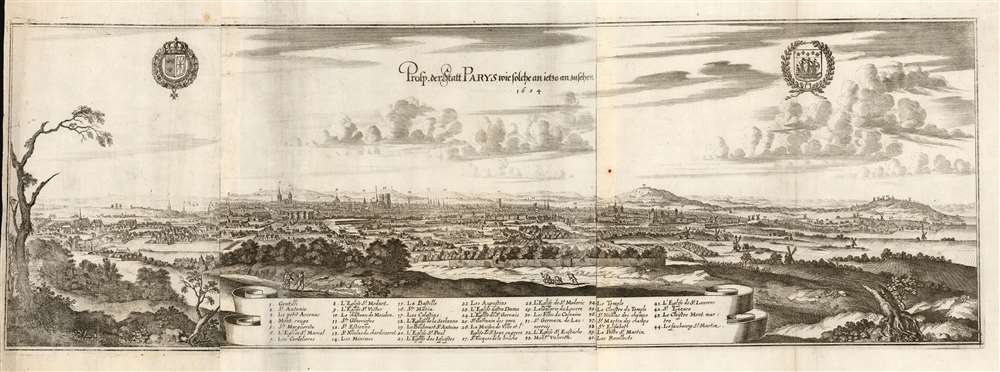
This item below is out of stock, but another example (left) is available. To view the available item, click "Details."
Details
1654 Merian Panorama of Paris
$2,200.00
1654 Merian Panorama of Paris
Paris-merian-1655
Title
1655 (dated) 10.25 x 31 in (26.035 x 78.74 cm)
Description
Landmarks of Note
Forty-four structures and places are listed below the view with a numbered key: Notre Dame can be easily found, as can be La Bastille, and other structures both inside and outside the city walls. Diminutive figures can be seen moving along the roads and fields in the foreground, and the countryside around the city is peppered with windmills. Should travelers have happened on Paris from the northeast, this is what they would have seen.Publication History and Census
This view was created by Caspar Merian for inclusion in his Topographiae Gallae,, published in Frankfurt am Main in 1655 with a further editions 1661. The Topographiae is well-represented in institutional collections. Although this view does appear on the market from time to time, it is catalogued only once in OCLC as a separate engraving.Cartographer
Matthäus Merian (September 22, 1593 - June 19, 1650), sometimes referred to as 'the Elder' to distinguish from his son, was an important Swiss engraver and cartographer active in the early to mid 17th century. Merian was born in Basel and studied engraving in the centers of Zurich, Strasbourg, Nancy and Paris. In time Merian was drawn to the publishing mecca of Frankfurt, where he met Johann Theodor de Bry, son of the famed publisher Theodor de Bry (1528 - 1598) . Merian and De Bry produced a number of important joint works and, in 1617, Merian married De Bry's daughter Maria Magdalena. In 1623 De Bry died and Merian inherited the family firm. Merian continued to publish under the De Bry's name until 1626. Around this time, Merian became a citizen of Frankfurt as such could legally work as an independent publisher. The De Bry name is therefore dropped from all of Merian's subsequent work. Of this corpus, which is substantial, Merian is best known for his finely engraved and highly detailed town plans and city views. Merian is considered one of the grand masters of the city view and a pioneer of the axonometric projection. Merian died in 1650 following several years of illness. He was succeeded in the publishing business by his two sons, Matthäus (1621 - 1687) and Caspar (1627 - 1686), who published his great works, the Topographia and Theatrum Europeaum, under the designation Merian Erben (Merian Heirs). Merian's daughter, Anna Maria Sibylla Merian, became an important naturalist and illustrator. Today the German Travel Magazine Merian is named after the famous engraver. More by this mapmaker...

